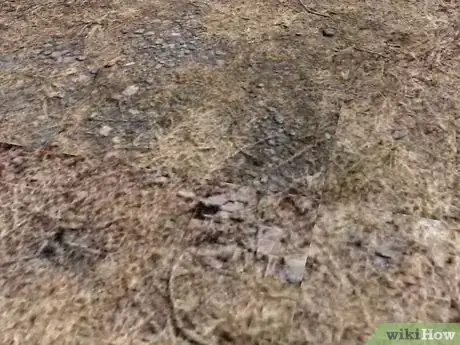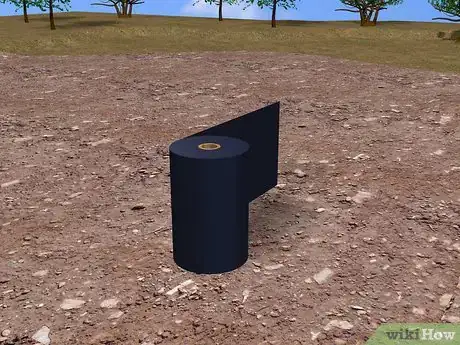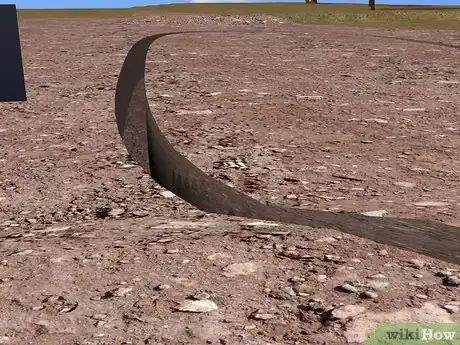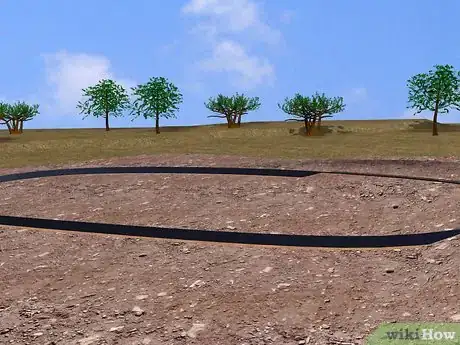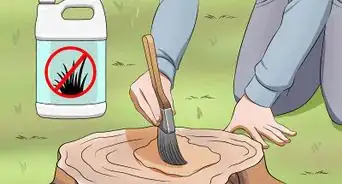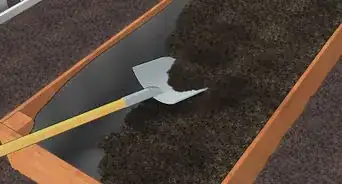X
wikiHow is a “wiki,” similar to Wikipedia, which means that many of our articles are co-written by multiple authors. To create this article, 23 people, some anonymous, worked to edit and improve it over time.
wikiHow marks an article as reader-approved once it receives enough positive feedback. In this case, 93% of readers who voted found the article helpful, earning it our reader-approved status.
This article has been viewed 165,231 times.
Learn more...
While it is possible to control the spread of bamboo with easier methods, a bamboo barrier is the longest lasting and lowest maintenance method of containing aggressive forms of bamboo.
Steps
-
1Determine the area to contain the bamboo in. The larger the area, the larger your bamboo will be able to grow. Those focused exclusively on the vigor of bamboo recommend as much as a 30 feet (9.1 m). diameter for large species. However, it is possible to have a reasonably large healthy plant with as little as one square yard of ground for it to grow in.[1]
-
2Remove or plan on killing any rhizomes outside of the contained area. Killing well-established bamboo is very difficult, so removing the rhizomes upfront is probably the better option.Advertisement
-
3Choose and purchase the rhizome barrier. Bamboo can be very strong, and rhizomes have a sharp tip when growing. Concrete will crack over time and allow the bamboo to escape. Metal will eventually rust through and poses a hazard where it must stick up above ground. For best results, use a true HDPE (High-Density Polyethylene) barrier of at least 60 mil thickness. The American Bamboo Socia In hard clay soil, some say it is okay to use only a 24 inch (61.0 cm) wide barrier. However, a 30 wide barrier is safer. For areas where the soil is sandy and loose, a 36 inch (91.4 cm) wide barrier may be required.[2]
-
4Dig a trench around the area to be contained, about 2 inches (5.1 cm) shallower than the width of your rhizome barrier.[3]
-
5Compact the bottom of the trench as well as possible. Keep the topsoil that you dug out from falling back in. You want this to be hard uninviting clay in case a rhizome ever makes it down that far.
-
6Place the barrier into the trench. Get it where you want it to be, and do your best to angle it away from the enclosed area. You want any rhizome that hits the barrier in the future to be directed up by the barrier. You do not want the rhizome to go down, as this can lead to a rhizome escaping under the barrier even if it is good and deep.
-
7Close the ends of the barrier. Either use steel closure strips with a less than 3 inch (7.6 cm) overlap, or overlap the ends by at least four feet and seal the overlap at both ends with double-sided tape. Bamboo can escape through very small openings, so make sure the seal is really good.[4]
-
8Begin filling in around the barrier. Keep the barrier angled outward. Pack the bottom half of the fill as tightly as possible. Let the top half remain loose.[5]
-
9The installation is complete. Your bamboo should not be able to escape underground. It will eventually send rhizomes over the 2 inch (5.1 cm) high above-ground part of the barrier. However, these are easily spotted and clipped with a quick inspection once or twice per year.
Advertisement
Community Q&A
-
QuestionWhere can I purchase it and how much does it cost?
 Community AnswerHere in Australia, you can buy it at any hardware/home improvement store for about $6/meter. Do a Google search for "garden edging" and you should get some idea.
Community AnswerHere in Australia, you can buy it at any hardware/home improvement store for about $6/meter. Do a Google search for "garden edging" and you should get some idea.
Advertisement
Warnings
- Metal barriers pose a hazard as sharp edges stick up above ground. Stick with HDPE as it is more effective and easier to work with anyway.⧼thumbs_response⧽
- Even when containing very large areas, barriers do reduce the quality of the environment for your bamboo. Because they block all air and water flow as well as rhizomes, it is somewhat like making the bamboo's house a little more stuffy. In most cases, this will only have a minor effect on the bamboo's health, but it is not a good idea if you are trying to grow a prize-winning specimen.⧼thumbs_response⧽
Advertisement
Things You'll Need
- A trenching tool, mechanical or otherwise.
- A compacting tool, such as a 4' length of 4X4 or similar heavy object with a flat end.
- HDPE Rhizome barrier.
- Barrier closure strips or an extra-long barrier and some double-sided tape.
References
- ↑ http://palmvrienden.net/gblapalmeraie/2017/08/25/how-to-install-a-bamboo-rhizome-barrier/
- ↑ https://hardytropicals.org/blog/installing-a-bamboo-barrier
- ↑ https://hardytropicals.org/blog/installing-a-bamboo-barrier
- ↑ http://palmvrienden.net/gblapalmeraie/2017/08/25/how-to-install-a-bamboo-rhizome-barrier/
- ↑ http://www.bamboogarden.com/barrier%20installation.htm#barrier%20enclosure
About This Article
Advertisement

